15 Fascinating Facts About The Mastiff
The Mastiff is a breed of dog that originated in Tibet. There are over 14
different breeds of mastiff, which are all unique in their own ways. The Mastiff
was recognized as an official breed by the American Kennel Club (AKC) in 1885,
and is currently ranked at number 26 out of 175. Their history, size, and
temperament make them desirable as pets for those who live in a home large
enough to house these large dogs.
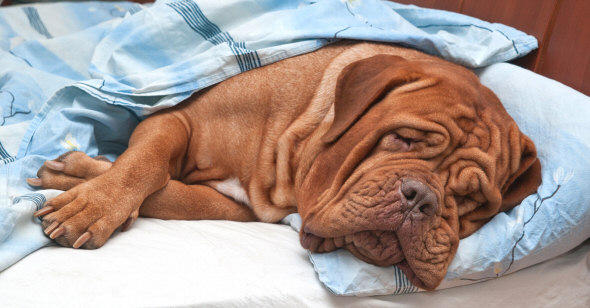
15) They Have a Unique History
|
Mollossus:
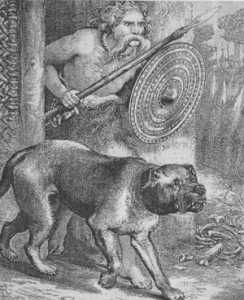
|
The Mastiff is considered to be one of the most
ancient breeds of dogs. The earliest ancestor of the Mastiff was the Molossus,
which lived over 5,000 years ago. The Mollossus, who lived in the Asian
mountains, was a ferocious dog that was typically used as a guard dog. Pictures
of these dogs have been found throughout Egyptian, Greek, and Babylonian
history.
The modern Mastiff was developed in England, where it was necessary to have a
huge dog to guard grand estates. Lyme Hall, in particular, was well known for
having saved the breed from extinction in 1835. During this time, the breed was
used in brutal sports, which led to dog-fights being outlawed. With the help of
Lyme Hall and a surge in dog shows, the breed was able to survive. The breed
faced extinction again throughout World War I and II, when there were food
shortages. These shortages made it almost impossible to keep them fed, and were
often found dead from starvation. After World War II, a pair of Mastiff puppies
was used to help bring the breed back from extinction. The Mastiff Club of
America, formed in 1929, was established to ensure the health and well-being of
the breed since its inception.
14) Largest Breed of Dog
Though there are many breeds that are considered to
be huge, none of them can truly compare to the Mastiff in terms of mass. The
average height of a male Mastiff is 30 inches, and their average weight is
175-190 pounds. Female Mastiffs usually have a height of 27.5 inches, and weigh
between 175 and 195 pounds. In terms of height, the Mastiff is considered to be
the third tallest dog, behind the Irish Wolfhound and the Great Dane. The mass
and height of these dogs often make them appear formidable to strangers, which is
why they are often used as guard dogs.
English Mastiffs:
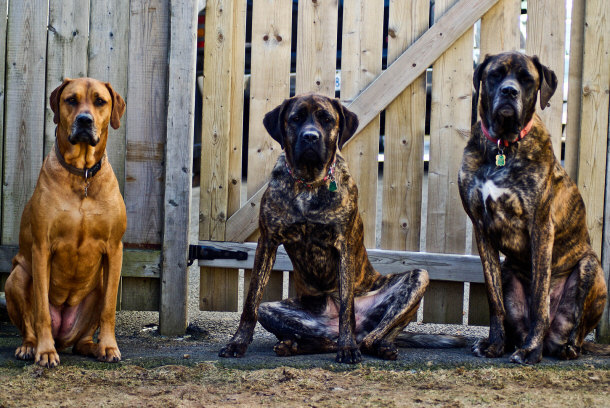
The reward for the biggest dog goes to an English Mastiff by the name of
Cloe. Cloe was a Mastiff that lived in Tibet during the 1980s. Cloe was said to
have weighed about 365 pounds, and was 38 inches tall. Other notable Matisffs
include Zorba and Hercules. Residing in the U.K., Zorba weighed in at 343, was
37 inches tall, and had a length of 8 feet and 3 inches. Hercules, from
Massachusetts, weighs in at 282 pounds and has a neck that measures in at 38
inches.
13) The Oldest Mastiff Lived to be 15 Years
|
Kush - Longest living Mastiff:
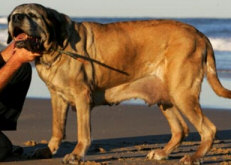
|
On average, a Mastiff will live
for about 10 years. However, there have been some exceptions to this norm. The
longest living Mastiff was a female that went by the name of Kush. Kush, who
resided in Australia, lived to be over 15 years old. In Mastiff years, that
amounted to about 105 years.
The secret in Kush’s long life is believed to be a result of the way that her
humans fed and cared for her. Her owners gave her a strict diet of bones, raw
meat, herbs, and vegetables. Kush was not fed on a daily basis like most dogs.
Her owners believed that they should stick to the feeding habits of wild dogs.
With wild dogs, they make a kill every few days and gorge themselves, so they
stuck to a feeding schedule similar to that. Additionally, her owners never took
her to the vet, so she was never exposed to any antibiotics or chemicals.
Throughout her life, Kush gave birth to 60 pups, and would go to the local
hospice to visit patients.
There have been other reports where a Mastiff would live to be 12 or 13 years
old, but it is not common. In most of these cases, the owners fed their dogs
organically and did not follow medical trends with their pets. Whether these
organic diets and lifestyles were the cause of a long life or just a coincidence
has remained to be unproven.
12) Each Breed of Mastiff has a Specific Purpose
Some think of the Mastiff in terms of being a singular breed. However, there are over 14 different breeds in the Mastiff
family. Each breed was created for a different purpose and
comes with different physical and personality traits. The different breeds in the Mastiff family include:
Argentinian Mastiff
The Argentinean Mastiff is playful, powerful, and loyal. They require a lot of
leadership, but have been known to make great guard dogs. They do very well with
other pets that they are raised with, but can show aggression to animals that
are unknown to them.
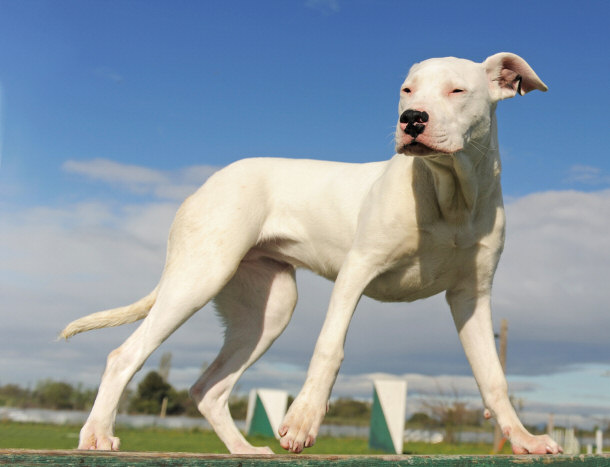
Brazilian Mastiff
The Brazilian Mastiff, a mix of Mastiff and
Bloodhound, are dedicated protectors to those that they live with. The breed can
be hard to handle at times, but are a great breed for owners with smaller
children.
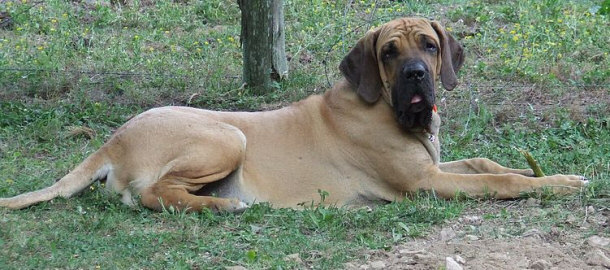
Bullmastiff
The Bull mastiff is a mix of bulldog and mastiff, and is known to be quite
stubborn. These dogs are typically considered to be lazy, but can be fierce when
they feel threatened.
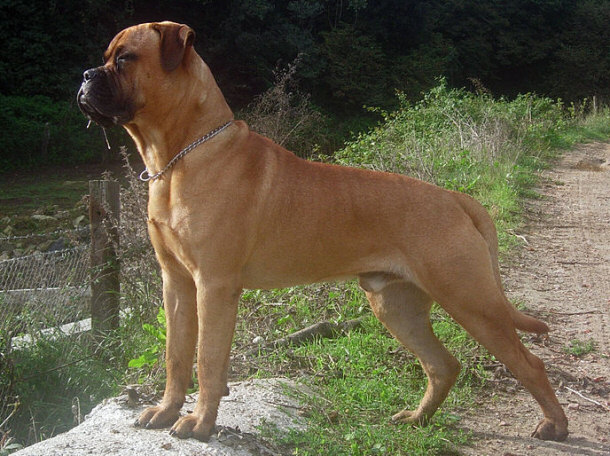
English Mastiff
The English Mastiff is extremely gentle, and makes a great house dog. The
English Mastiff is the largest in the Mastiff family, but is also the least
aggressive. One of the English Mastiff’s most notable traits is the amount of
drool that they can produce.
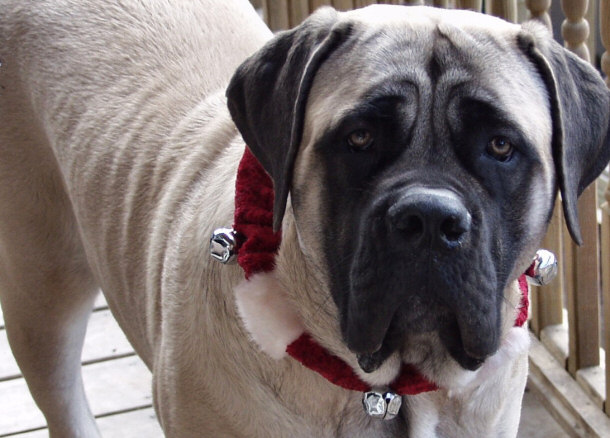
French Mastiff
The French Mastiff is smaller in size than some of the others, but can be just
as fierce. Though they are known to do well with their human family, they are
not very tolerant of strangers.
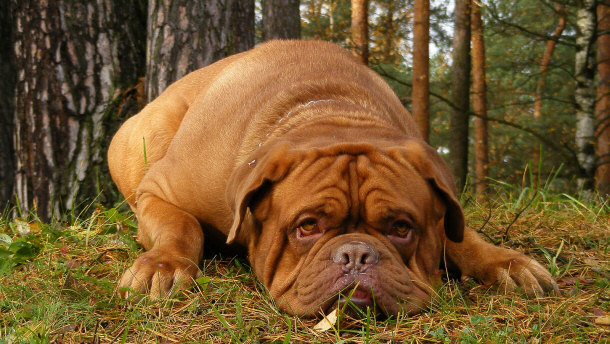
German Mastiff
This dog is also known as the great dane and are generally the tallest breed of
dogs. The famous cartoon dog Scooby Doo is considered a german mastiff.
However these dogs are not as scary as they look, they have slow metabolisms and
are considered to be less aggressive than other breeds of mastiffs.
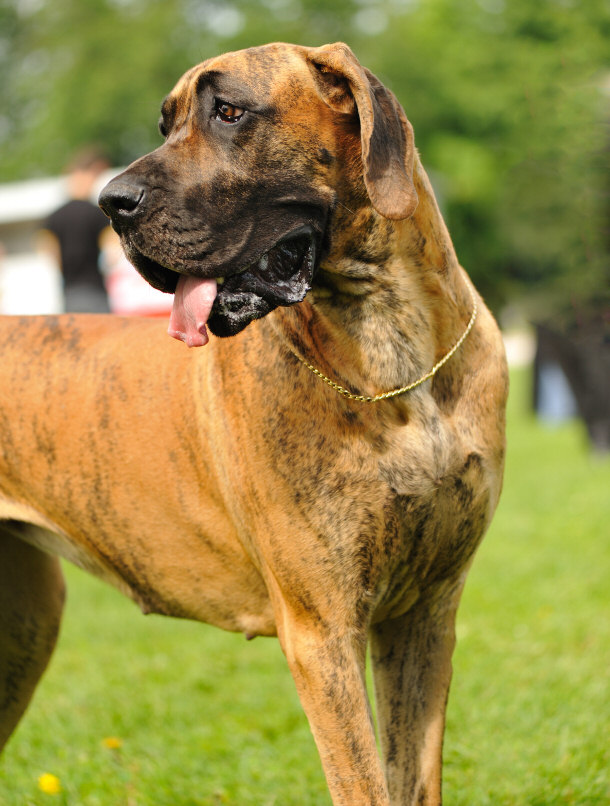
Italian Mastiff
Also known as the Cane Corso Italiano, these dogs are built tough with great
endurance. This dog makes a great family pet and will do a really good job
at keeping your family safe, as they make great watch dogs.
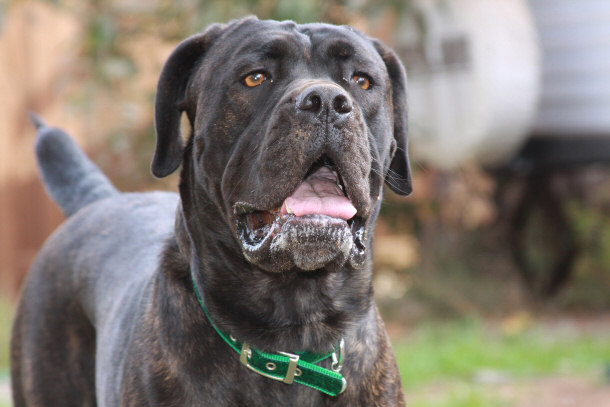
Neapolitan Mastiff
Another Italian breed, the Neapolitan Mastiff were originally bred as war dogs
and make for decent family guard dogs. These dogs have think hanging
wrinkles and folds of skin around their face. They are one of the most expensive
of the Mastiffs to maintain but make great peaceful yet powerful family pets.
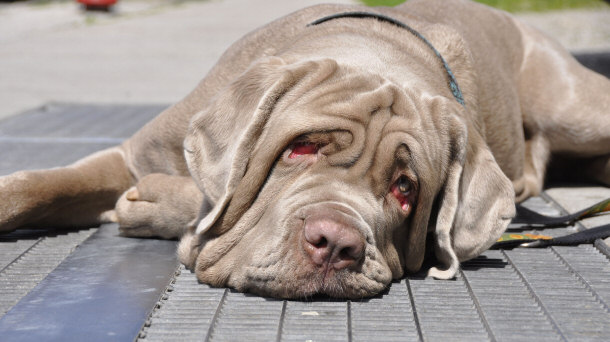
Pyrenean Mastiff
These dogs were originally bred as big and powerful livestock protectors.
These dogs make great family pets nowadays.
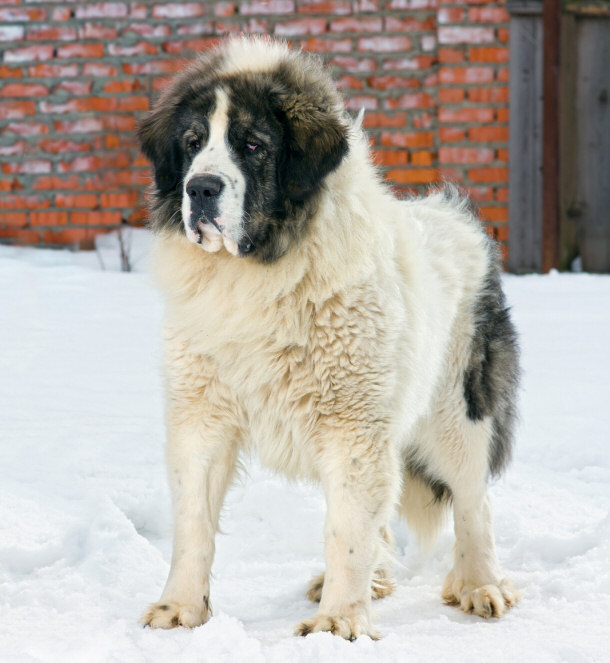
Spanish Mastiff
Another dog that was originally used as livestock guardian dogs. These
powerful stocky looking dogs are very loyal and will do anything to protect
their owners.
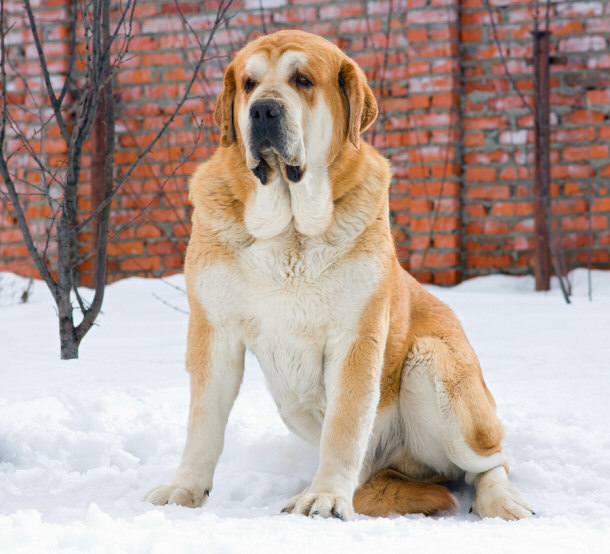
Tibetan Mastiff
The Tibetan Mastiff is incredibly territorial, strong willed, and independent.
They can easily become destructive if they are bored or confined.
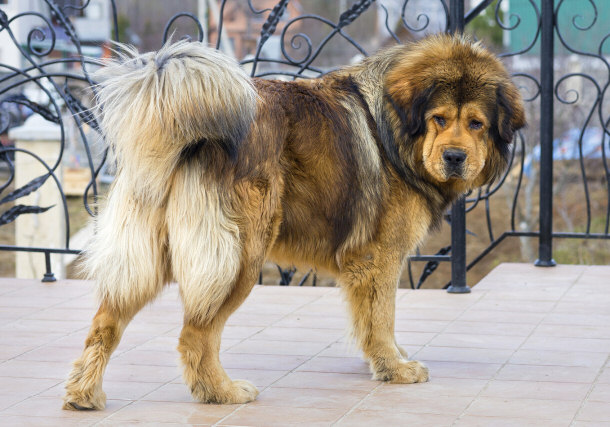
11) The Breed Has Had Many Famous Owners
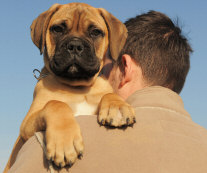 Over the past decade the Mastiff has
become a popular breed to have. Their temperament, history, and appearance make
them a desirable dog to own. The Mastiff has even been able to charm those who
are famous. Famous people in the film industry that own a Mastiff have included
Marlon Brando, Kirstie Alley, Gayle King, George C. Scott, and Michael Bay.
Famous musicians who have owned Mastiffs include Flea, Bob Dylan, Jon Bon Jovi,
and Christina Aguilera. Notable historical figures who have owned Mastiffs
include Hannibal, Kublai Khan, and Alexander the Great. Over the past decade the Mastiff has
become a popular breed to have. Their temperament, history, and appearance make
them a desirable dog to own. The Mastiff has even been able to charm those who
are famous. Famous people in the film industry that own a Mastiff have included
Marlon Brando, Kirstie Alley, Gayle King, George C. Scott, and Michael Bay.
Famous musicians who have owned Mastiffs include Flea, Bob Dylan, Jon Bon Jovi,
and Christina Aguilera. Notable historical figures who have owned Mastiffs
include Hannibal, Kublai Khan, and Alexander the Great.
For the most part, these former owners have helped to raise awareness about
the Mastiff breed. For example, Michael Bay has placed his Mastiff in several of
his films. He has also been known to make donations to local Mastiff rescue
groups in an effort to find misplaced Mastiffs good homes.
10) The Breed Faces Many Different Health Risks
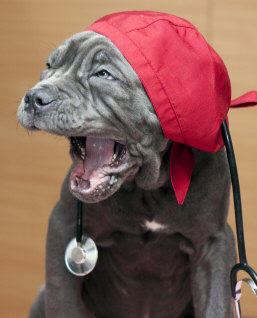 Like with any breed, there are
common health risks that the Mastiff faces. These health risks can cause some
dog lovers to re-think their choice in breed. Common
health risks include joint and structural problems, heart conditions, eye
diseases, bloating, cystinuria, and cancer. Like with any breed, there are
common health risks that the Mastiff faces. These health risks can cause some
dog lovers to re-think their choice in breed. Common
health risks include joint and structural problems, heart conditions, eye
diseases, bloating, cystinuria, and cancer.
These joint and structural problems usually mean that owners cannot over-feed
or over-exercise their Mastiffs. Doing so can result in injuries that can lead
to crippling later in life. A common structural problem that is seen in Mastiffs
is dysplasia. Dysplasia is a genetic hip deformity that may require surgery. In
dysplasia, the top of the dog’s thigh bone will not fit into the hip socket
properly. Over time, the underlying bone and cartilage will become damaged, and
will result in arthritis. Common heart conditions include pulmonic stenosis,
cardiomyopathy, and mitral dysplasia. Eye diseases include corneal dystrophy,
retinal dysplasia, and retinal atrophy. Each of these heart or eye conditional
will require surgery to fix, which can get quite expensive.
Though bloating can be common with any breed, it is almost for sure with the
Mastiff. Bloating is so dangerous in large breeds because it can cause their
stomach to twist, which will cut off blood flow. In most cases, surgery will be
required and the condition could even lead to death if it goes untreated.
Cystinuria is a kidney defect that causes the formation of kidney stones.
Surgery will be required to remove the stones and to repair any damage that
occurs. Cancer is also common in Mastiffs, and will require immediate treatment.
The treatments can be extremely expensive, so it is important that you take
these common health issues into account when choosing a Mastiff as a pet.
9) The Breed Has Made Many Hollywood Appearances
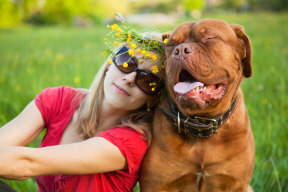 Because Mastiffs have become
such a popular breed to own, it's not surprising that they have been featured
in movies and television. While in some cases a Mastiff has a smaller role in
the movie or TV show, there have been cases where the Mastiff is the star of the
show. Movies that have featured a Mastiff include "Sandlot," "Transformers 2,"
"Hotel for Dogs," "RV," "Harry Potter," "Turner and Hooch," and "Marmaduke,".
These movies have not only increased exposure for the breed, but have created
respect for the breed. Because Mastiffs have become
such a popular breed to own, it's not surprising that they have been featured
in movies and television. While in some cases a Mastiff has a smaller role in
the movie or TV show, there have been cases where the Mastiff is the star of the
show. Movies that have featured a Mastiff include "Sandlot," "Transformers 2,"
"Hotel for Dogs," "RV," "Harry Potter," "Turner and Hooch," and "Marmaduke,".
These movies have not only increased exposure for the breed, but have created
respect for the breed.
Though some will argue that a movie or television set is no place for a dog,
the breed does well with the activities that these projects require. The breed’s
quiet demeanor, intelligence level, and over all personality help them to be
easy to work with and to train. Like with any breed, the type of training,
ownership responsibility, and living conditions will be a large factor when
deciding whether or not a dog can perform properly on a set.
8) Caring for a Mastiff is Expensive
Caring for any dog will require you to
have to plan financially. Vet bills, training, cost of food, play toys, and in
some cases pet rent, are all costs that you will have to consider. For a
Mastiff, however, these costs can be much more expensive for Mastiff owners. Vet
bills can be quite costly because the Mastiff has numerous medical conditions
that are common. Because some breeds of Mastiff can be stubborn, behavioral
training could end up being expensive.
Washing your Mastiff:
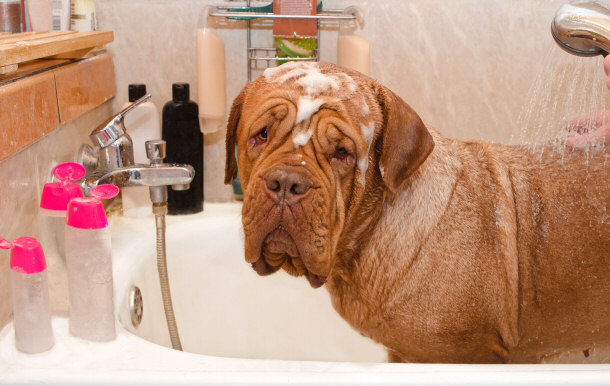
The cost of food alone could be a cause for you to re-think getting a
Mastiff. You should feed your Mastiff six to eight cups of dry dog food every
day. Since they are prone to bloating, you will want to make sure that you give
your dog high quality dog food. The high quality dog food, though better for
your dog, can be extremely expensive. Any surgeries that your Mastiff will
require throughout its life will not come cheap. While some surgeries or
treatments can cost around $1,000, others can cost up to $5,000. With how
expensive dog food and veterinary costs are, you could end up spending over
$15,000 in care throughout its life span.
7) They Produce the Largest Litters
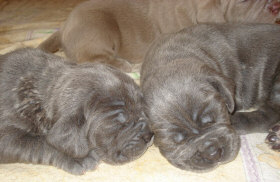 Because Mastiff’s are so large, it is no surprise that they tend to have
large litters. The typical littler will have 10 to 12 puppies. However, the
Mastiff breed holds the record for most puppies born in a single litter. In
2004, a Mastiff in England gave birth to 24 puppies. Out of these 24 puppies, 20
survived past the first week. It was the largest group of puppies to survive
past the first week. Because Mastiff’s are so large, it is no surprise that they tend to have
large litters. The typical littler will have 10 to 12 puppies. However, the
Mastiff breed holds the record for most puppies born in a single litter. In
2004, a Mastiff in England gave birth to 24 puppies. Out of these 24 puppies, 20
survived past the first week. It was the largest group of puppies to survive
past the first week.
Even though a littler of 24 is not typical, caring for a pregnant Mastiff,
and the puppies once they are born can be costly and stressful. With a
gestational period of 64 days, the pregnancy period is strenuous on both dog and
owner. Your mastiff will require extra food, and you will have to prepare a
space to handle all of the puppies that are born. You will have to keep in mind
that the puppies will require vaccines, a lot of food, and even more patience.
For these reasons, many make the decision to not breed their Mastiffs.
6) They Can Have Wildly Different Coat Colors
Mastiffs come in a variety of colors. Typical colors include blue, fawn,
apricot, brindle, red, and gold. Extremes of color are also present. The
Argentinian mastiff, or Dogo Argentino, is an all-white mastiff. On the opposite
end lies the nearly jet-black Rottweiler, classified as a mastiff-type dog.
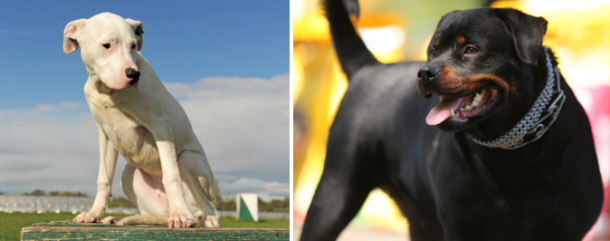
Still, the different possible colors that a Mastiff does have are beautiful
and often appear to be unique. For example, the blue coloring that some Mastiffs
are born with gives the Mastiff a majestic and somewhat formidable look. The
standard fawn coloring appears less formidable, but more aloof. The brindle
coloring that some dogs have is inverted to provide a cool affect on the dog's
coat. The color of Mastiff that you end up choosing will largely depend on your
personal preferences. Just keep in mind that the dog's coloring has no affect on
its personality or health. You should make sure that you are choosing a dog
based on personality and health, as opposed to coloring.
5) They Have Distinct Personality Traits
In addition to distinct coloring
traits, the Mastiff has very distinct personality traits and behaviors.
Typically the Mastiff will display temperaments such as courage, docility, and
good nature. Normal strangers are treated with a wary indifference, but will be
quick to act on threatening situations. Usually this behavior can be ended with
a few re-assurances from their owner. Should the behavior continue or escalate,
it is important to remove your dog from the situation to prevent any injury.
Tibetan Mastiff Puppies:
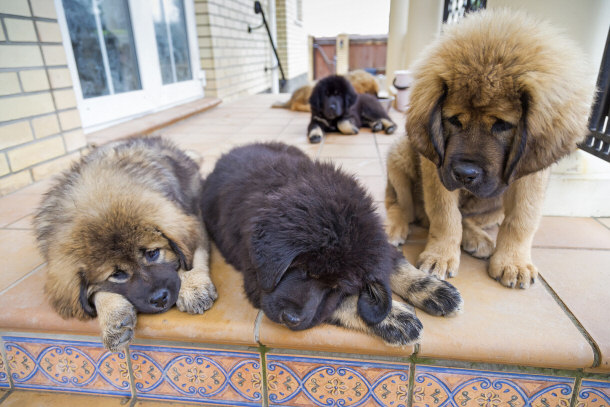
Though they are very close with their human families, arguing in front of
them is not a good idea. Mastiffs have been known to try to intervene in family
arguments. This can lead to injury for yourself, or the other human. The overall
temperament of your Mastiff will depend on how you treat it and the behaviors
that you expose it to while it is a puppy. If you allow your Mastiff to be
aggressive as a puppy, even in play, you will have to work hard to break those
traits later in its life.
When you are first picking out a Mastiff puppy, it is important that you
follow a few rules. First off, you should spend some time with the litter so
that you can get a better idea for the puppy’s temperament. After you get a good
feel for each puppy’s temperament, you should select the puppy that has a middle
of the road temperament. You should always make sure that you are able to assess
one of the parents. This will allow you to get a better feel for that litters
possible personality.
4) Only Adults Need Daily Exercise
Like most dogs, your Mastiff will require
exercise. However, you should not start an exercise schedule for your Mastiff
until after 18 months, when it is considered to be full grown. While your
Mastiff puppy is growing, their bones and joints need to be able to develop
properly. An excess amount of exercise may cause your dogs sensitive joints and
bones to become damaged or to not grow properly. During your Mastiff’s puppy
period, it is important to let them exercise at their own pace, and to rest when
they feel like they need to.
Dogue De Bordeaux (French Mastiff) running in a lake:
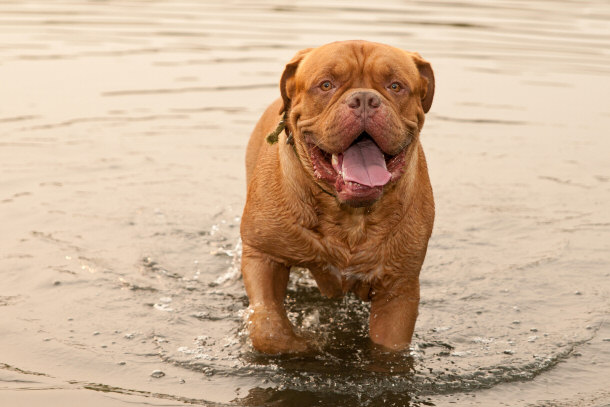
Once your Mastiff has reached adulthood, you should begin to take your dog
for daily walks. These daily walks should not be strenuous, as this breed is
just sensitive to exercise. Because your Mastiff’s joints and bones will always
be sensitive, and because they are so heavy, the slightest weight gain can do a
lot of harm to them. You will also want to re-affirm that you are providing your
dog with an appropriate diet. This means no fatty table scraps, and a regular
feeding schedule.
3) They Used to be Bred for Animal Fights and War
A more gruesome part of
the Mastiff history, is that they used to be bred for animal fights and war.
Once it became apparent that Mastiffs could make vicious guard dogs, some
society leaders decided to include them in war and vicious sports. As far back
as 2,500 years ago, Mastiff style dogs were depicted fighting bears and lions.
As a sport the owner of a Mastiff would train their dogs to be vicious fighters.
This would often involve the dog being beaten, starved, and secluded. Once the
owner felt that the dog was vicious enough, the dog would be placed in an
arena-type setting with another animal. Oftentimes, the other animal was a bear
or lion, but would sometimes include other dogs. The owner would take and place
bets on the outcome of the fight, which always went until the death of one of
the animals.
.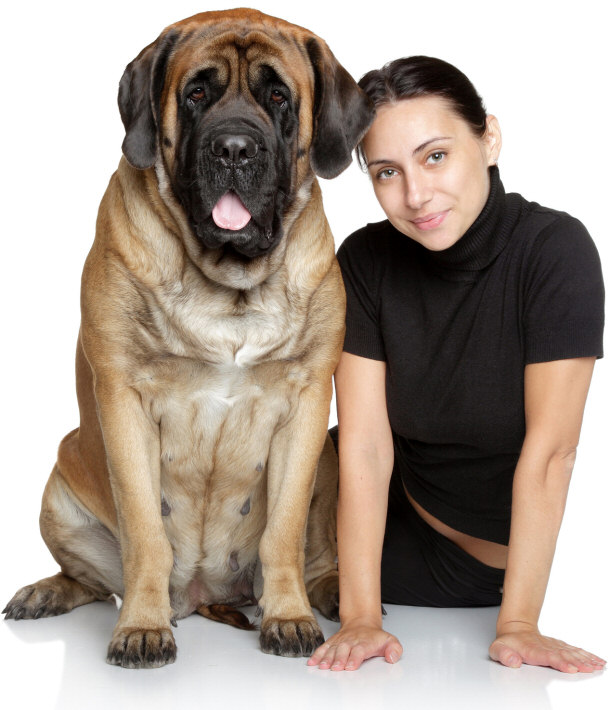
Kublai Khan was said to have a kennel of over 5,000 Mastiffs that were used
in war and for sport. He would often train Mastiffs to deliver letters, or to
stand guard over precious items or important guests. Also, when Hannibal went
through the Alps, he did so with his war Mastiffs. The animal fights and war
responsibilities that the Mastiff was subjected to almost caused their
extinction in the early 19th century. This dark history of theirs is also why so
many people have an opinion that they are naturally aggressive animals.
2) The Red Tibetan Mastiff is the Most Expensive Dog in History
The title of
the most expensive dog in history belongs to a red Tibetan Mastiff by the name
of Big Splash. Big Splash belongs to a man in Northern China, and costs around
$1.5 million. The dog is kept on a diet that consists of beef, sea cucumber,
chicken, and abalone. Though the price seems quite remarkable, the breeder had
many ways to justify it. One reason for the hefty price tag was that the breeder
spent a lot of money on staff to raise the dog. Also, every time that the owner
decides to breed Big Splash, he can depend on making around $15,500 every time.
Big Splash:
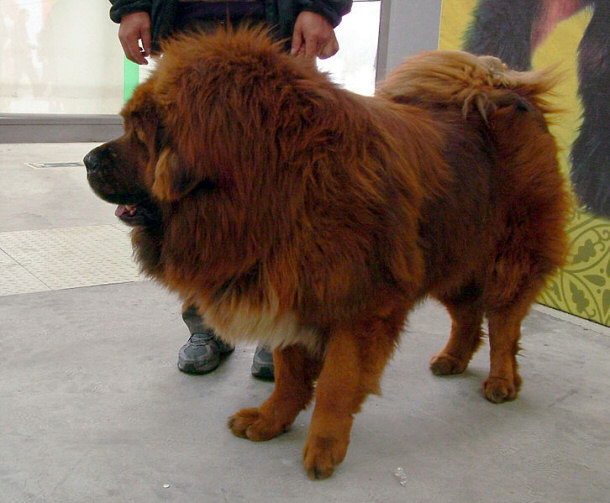
In China, an expensive dog is a price of status. According to the breeder,
there was no higher display of status than the purchase of Big Splash. In China,
the color of red represents good fortune. Purchasing big Splash was the perfect
way of ensuring good fortune for the owner. Even by Mastiff standards, Big
Splash is expected to be huge when fully matured. The dog is expected to grow to
be around 290 pounds when full maturity is reached. Though many people would
never think of paying $1.5 million for a dog, these reasons were justifiable to
the breeder, and ultimately accepted by the new owner.
1) Believed to be Reincarnated Nuns and Monks
One of the most interesting
views of a Mastiff is that the Tibetan Mastiff are the reincarnated souls of
monks and nuns. According to Tibetan’s, the souls of the monk and nuns were not
good enough to be reincarnated in to people or to get into Shambhala. Because
these souls were not good enough, they were placed into the body of the Tibetan
Mastiff. This was one of the ways that locals explained why the Tibetan Mastiff
were so protective and ready to guard the locals monasteries, villages, and
flocks.
Tibetan Mastiff and his Puppies:
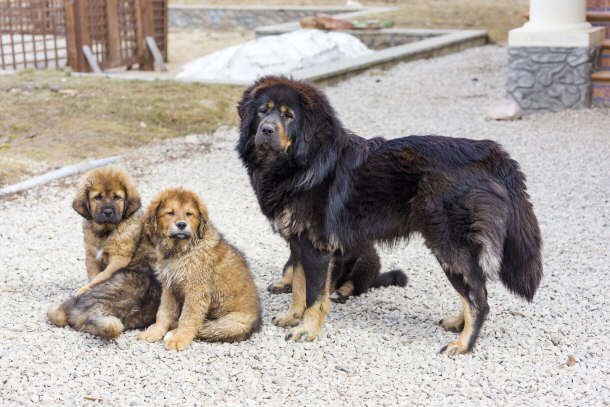
This legend has made the Tibetan Mastiff the most sought after and admired
breed in the Tibet area. Locals seem to respect the breed more than other
breeds. Monks can often been seen nodding to Tibetan Mastiffs whose soul they
believe they recognize.
Final Words
The Mastiff is one of the most interesting and ancient breed of dog alive
today. The breed has survived a gruesome history that was filled with two
possible extinctions. While there has been many who have abused the Mastiff’s
size and strength, there have been humans who have fiercely protected and
respected the breed. The Mastiff Club of America, the American Kennel Club,
passionate owners, and the monks of Tibet, are just a few examples of those who
love the Mastiff breed.
One of the main reasons that this breed is so well-loved is the aloofness
that tends to appear in all Mastiff breeds. The Mastiff is a creature that is
close and lovable towards its human family, but will not think twice about
attacking an intruder. The Mastiff is also known to live well with kids and
other animals that they are familiar with. This attribute makes them an
appealing option for a pet.
Though the Mastiff may seem like an appealing pet, it is important to make
sure that you can properly care for one. Because these dogs are so large, they
would be better off living on a property with lots of space. You should also
make sure that you will be able to afford the Mastiff, because they are very
expensive to own. If you cannot provide a suitable living space, or if you would
have trouble affording their lifestyle, you should choose a breed that is better
suited for the lifestyle that you can offer.
Pets
Top Lists:
18 Richest Animals in the World
15 Exotic Pets You Could Own Today
Top 20 Common Substances That Are Toxic to Cats and Dogs
Informational:
Animal Actors: Pets in the Film, TV, and Print Industry
Caring for a Yorkshire Terrier: Facts You Should Know
Caring for a Pig as a Pet: The Pot-bellied Pig and the Micro Pig
Difference Between a Cat Person And a Dog Person
Should You Microchip your Cat or Dog?
How to Raise and Care for Pygmy Goats
Caring for Unique Pets: The Leopard Gecko
Use Food-Grade Diatomaceous Earth to Kill Fleas Naturally
Dogs:
Top Lists:
Top 15 Dog Breeds For Home Protection
15 Fascinating Facts About The Mastiff
Informational:
How To Teach Your Dog to Hunt for Truffles
Caring for an English Bulldog: Tips and Basic Info
Cranial Cruciate Ligament (CCL) Tears in Dogs: Treating the Injury
How To Keep Your Dog free of Heartworm Disease
Dog With Separation Anxiety?
Cats:
Top Lists:
Top 6 Qualities in an Awesome Cat
Informational:
How to Control Fighting Felines
How to Get Your Cat to Exercise
Fish:
Fish 101 for the Hobbyist: The Fish’s Body and Senses
Buying a Saltwater Aquarium: What You Need to Know
Graduating to a Saltwater Tank
|